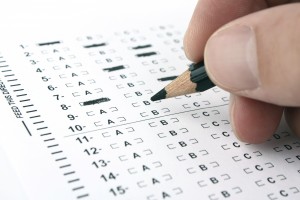Bill to reduce time spent on tests inadvertently creates furor over clocking bathroom breaks

Date Posted: 3/24/2016 | Author: Monty Exter
Even the most well-meaning laws can cause major headaches. Last session's House Bill (HB) 743 by Rep. Dan Huberty (R–Humble) was praised as a major win by test reduction advocates when it was signed into law in 2015, after a similar bill had been vetoed the previous session. However, the manner in which the bill is now being interpreted by state and local officials is causing some upset among many Texas educators involved in the administration of state tests.
In addition to other means of streamlining, reducing, and validating the state tests, HB 743 requires that certain state assessment instruments (i.e. STAAR tests) must be designed so that 85 percent of students taking the tests will be able to complete the test within 120 minutes (for students taking tests in grades three through five) or 180 minutes (for students taking tests in grades six through eight). Under the bill that passed, students are still to receive eight hours or one full school day to complete the test, but the test must be sufficiently short that the vast majority of students can complete it before the onset of significant test fatigue. All of these stipulations were considered by pro-test-reduction advocates to be a good thing when HB 743 was considered and passed.
 Unfortunately, this well-meaning bill has resulted in some unforeseen consequences now that it is being implemented. The issue at hand is this one: in order for the Texas Education Agency (TEA) to determine how much state tests might need to be shortened in the future in order to comply with the new law, TEA must first determine how much time students are currently spending on the tests.
To calculate the actual time most students are taking to complete the test, the agency decided to have all test administrators record two things during the current testing year. In one column, administrators are being asked to record the amount of time each student spends taking the test from beginning to end in 15-minute increments with a minimum time of one hour. In a second column, administrators are to record the amount of time a student spends away from the test after its administration has begun but before the student completes the test, again in 15-minute increments. Time spent away from the test would include things such as rest breaks at the student’s desk, restroom breaks, and water breaks.
TEA staff indicates that the agency's intention was for the time recorded in the second column to be a rough estimate and not a strictly clocked amount of time for breaks. Of course, there is nothing in the instructions to indicate that this was TEA's specific intent, or to indicate that TEA wanted more than a rough estimate; the instructions are silent on the matter. Additionally, there was nothing in Rep. Huberty's HB 743 that required TEA to exclude things like water breaks and restroom breaks, or any breaks for that matter, from the amount of time it takes a student to complete the exam for purposes of their study; the decision to track time spent on students' breaks was an administrative choice.
In the absence of clear guidance from TEA, at least some, and potentially quite a few, districts are interpreting the instructions to require test administrators to strictly clock any time a student spends away from the test prior to completing it. As we have heard from several concerned ATPE members, this creates a huge administrative burden for one person, who is already tasked with significant test security duties for perhaps 30 or more students, to keep track of every moment those students spend off test so that they can add up that time for each student and clock it along with the total time each student spent on the test.
Unfortunately, this well-meaning bill has resulted in some unforeseen consequences now that it is being implemented. The issue at hand is this one: in order for the Texas Education Agency (TEA) to determine how much state tests might need to be shortened in the future in order to comply with the new law, TEA must first determine how much time students are currently spending on the tests.
To calculate the actual time most students are taking to complete the test, the agency decided to have all test administrators record two things during the current testing year. In one column, administrators are being asked to record the amount of time each student spends taking the test from beginning to end in 15-minute increments with a minimum time of one hour. In a second column, administrators are to record the amount of time a student spends away from the test after its administration has begun but before the student completes the test, again in 15-minute increments. Time spent away from the test would include things such as rest breaks at the student’s desk, restroom breaks, and water breaks.
TEA staff indicates that the agency's intention was for the time recorded in the second column to be a rough estimate and not a strictly clocked amount of time for breaks. Of course, there is nothing in the instructions to indicate that this was TEA's specific intent, or to indicate that TEA wanted more than a rough estimate; the instructions are silent on the matter. Additionally, there was nothing in Rep. Huberty's HB 743 that required TEA to exclude things like water breaks and restroom breaks, or any breaks for that matter, from the amount of time it takes a student to complete the exam for purposes of their study; the decision to track time spent on students' breaks was an administrative choice.
In the absence of clear guidance from TEA, at least some, and potentially quite a few, districts are interpreting the instructions to require test administrators to strictly clock any time a student spends away from the test prior to completing it. As we have heard from several concerned ATPE members, this creates a huge administrative burden for one person, who is already tasked with significant test security duties for perhaps 30 or more students, to keep track of every moment those students spend off test so that they can add up that time for each student and clock it along with the total time each student spent on the test.
 Should TEA have used as small as possible a sample to simply extrapolate how long it was taking students to complete the test? Probably so. Should TEA have considered alternatives, such as developing a uniform deduction to approximate students' break time; asking administrators only to record actual resting breaks that are more than 15 minutes and not including quick bathroom or water breaks; simply not worrying about deducting break time at all; or at least providing clear instruction that the agency only expected a rough estimate of break times and not Olympic precision? Again, probably so. Thankfully, this additional ask of teachers, which is clearly more burdensome than was necessary, should only be with us for one year. After the current school year, TEA will have gathered the information it is seeking, and we should be able to get the shorter tests that were the objective of HB 743 in the first place.
In the meantime, we hope that TEA might take the initiative to provide school districts with additional clarifications on the expectations for tracking students' break time during the tests and that school district officials accordingly will also talk to their employees about the expectations and why these time periods are being tracked this year as estimates.
Should TEA have used as small as possible a sample to simply extrapolate how long it was taking students to complete the test? Probably so. Should TEA have considered alternatives, such as developing a uniform deduction to approximate students' break time; asking administrators only to record actual resting breaks that are more than 15 minutes and not including quick bathroom or water breaks; simply not worrying about deducting break time at all; or at least providing clear instruction that the agency only expected a rough estimate of break times and not Olympic precision? Again, probably so. Thankfully, this additional ask of teachers, which is clearly more burdensome than was necessary, should only be with us for one year. After the current school year, TEA will have gathered the information it is seeking, and we should be able to get the shorter tests that were the objective of HB 743 in the first place.
In the meantime, we hope that TEA might take the initiative to provide school districts with additional clarifications on the expectations for tracking students' break time during the tests and that school district officials accordingly will also talk to their employees about the expectations and why these time periods are being tracked this year as estimates.
CONVERSATION
RECOMMENDED FOR YOU

07/11/2025
Teach the Vote’s Week in Review: July 11, 2025
Gov. Greg Abbott makes the special session official, and President Donald Trump signs the “One Big Beautiful Bill.” Plus: Learn how you can help victims of the recent Texas Hill Country floods.

07/09/2025
Gov. Greg Abbott makes it official: Special session to begin July 21
The governor released the official proclamation Wednesday to bring the 89th Texas Legislature back to Austin for a special session.

07/03/2025
Teach the Vote’s Week in Review: July 3, 2025
A federal funding freeze threatens Texas schools and summer learning, and the U.S. House approves Trump’s “big, beautiful bill.”

